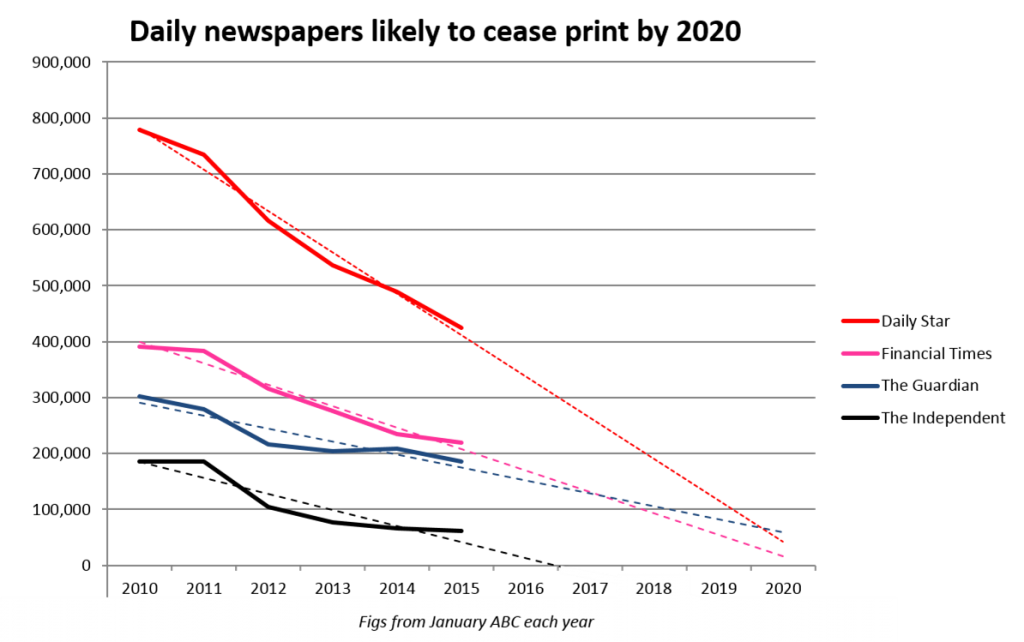by Atul Hatwal
Grim news last week with the closure of the Independent. Yes, I know it’s going to be continuing online and there will be some sort of future but not one that’s recongnisable to any regular reader of the Indy.
The sale of the ‘i’ tells us all we need to know about what happens next.
The print run of the Independent was always going to end. Last year I wrote a piece predicting its likely print demise in 2016 (along with that of the Guardian, the FT and Star by 2020). The long term sales trends were and are painfully clear.
However, contrary to the plan outlined by the Independent’s owners, scrapping the daily and Sunday newspaper needn’t have been the end of print for the Indy.
Keeping the “i” as a print outlet would have retained a physical presence for the brand and the lucrative print advertising revenue stream. The website could have been refocused, extending its long reads and deeper analysis along-side the inevitable clickbait and hourly reportage of whatever is trending on social media.
The combination of tabloid print with a website that had greater in-depth coverage would have been a genuinely interesting model, bringing together the strengths of both formats – print prestige, influence and revenue with mass online views and deeper pockets of analysis.
Keeping the ‘i’ would have meant retaining the core of print journalists whose content gives the Independent brand its identity.
The Indy would have remained true to its founders ideals.
Instead, with the disposal of the “i” and redundancies announced, it’s owners seem to have decided to let go of large numbers of the editorial staff who produced the paper and retain the digital journalists that write the bulk of website copy and who are, incidentally, much cheaper than their print contemporaries.
The fate of the Independent is partially a symptom of the organisation’s long term failure to reconcile the competing imperatives of digital and print.
Digital is about clicks and views, print about more nebulous goals such as influence, quality and insight. Digital can be comprehensively measured, print less so (beyond the obvious of newspaper sales which rarely tell a positive story.)
Over the past decade, print and digital newsrooms have developed as parallel ecosystems across the majority of newspapers, each exclusively pursuing their conflicting priorities.
Print teams have been snooty about the digital upstarts and unwilling to engage with such prosaic tasks as demonstrating value to accounting teams. For digital, it has been their raison d’etre.
As a result at the Indy, when budgetary push came to fiscal shove, the print team was cut.
It didn’t have to be this way.
Many of the “click-bait kids,” as some print journos describe the digital team, are easily capable of writing higher quality content. Print journalists are equally able to turn around copy quickly when needed
There is nothing innate about a publication format that determines content.
But the bifurcation of the newsroom between print and digital meant their values were never reconciled.
Digital has won out at the Indy and the sugary, instant hits of journalism driven by minute-to-minute views will now define its legacy.
All singles, chasing the sound of the moment. Less thought about the overall album or standing back from the immediate.
Shame.
Atul Hatwal is editor of Uncut
Tags: Atul Hatwal, digital publication, i, Independent, newspapers










Why is it going bust?
Could it be that nobody is reading it?
Listening to LBC, I realise that faux-working class Labour is becoming ridiculous – except for shrinking pockets in the BBC and Islington. Gender issues are frightfully interesting – to a minority. Immigration frightens an awful lot of people. Whingeing on about low pay and the vulnerable does not cut the mustard with a lot of thrusting young business people.
Meanwhile, I would like to know the figures for the Daily Mail.
Heh. Notice that the Independent, Guardian and Financial Times all have a clear distaste for the general public and sneering contempt for public opinion. I guess pleasing the metropolitan elite isn’t the same as being successful.
Still, as long as the Labour Party doesn’t go down that route I’m sure their popularity will grow and grow.